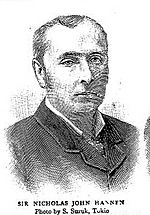Nicholas John Hannen facts for kids
Quick facts for kids
Sir
Nicholas Hannen
|
|
|---|---|
 |
|
| British Crown Advocate for China | |
| In office 1878–1881 |
|
| Preceded by | New position |
| Succeeded by | Hiram Shaw Wilkinson |
| Judge, British Court for Japan | |
| In office 1881–1891 |
|
| Preceded by | Richard Rennie |
| Succeeded by | Robert Mowat |
| Chief Justice, British Supreme Court for China and Japan | |
| In office 1891–1900 |
|
| Preceded by | Richard Rennie |
| Succeeded by | Hiram Shaw Wilkinson |
| Personal details | |
| Born | 24 August 1842 |
| Died | 27 April 1900 (aged 57) Shanghai International Settlement |
Sir Nicholas John Hannen (born August 24, 1842 – died April 27, 1900) was an important British judge and diplomat. He worked in China and Japan during the late 1800s. He was the Chief Justice of the British Supreme Court for China and Japan. This was the highest judicial position in those areas for Britain. He also served as a Consul-General in Shanghai. A Consul-General is like a country's official representative in a foreign city. Nicholas Hannen's brother, James Hannen, was also a well-known judge. His son, Nicholas "Beau" Hannen, became a famous actor.
Contents
Nicholas Hannen's Early Life
Nicholas Hannen was born on August 24, 1842. He was one of many children in his family. He went to school in London, attending the City of London School. Later, he studied at University College London.
After finishing his studies, he became a barrister in 1866. A barrister is a type of lawyer who argues cases in court. In 1868, he moved to Shanghai, China. There, he started his legal career. He married Jessie Woodhouse in 1869.
His Career as a Judge and Diplomat
Sir Nicholas Hannen held several important jobs in China and Japan. He worked as a judge and a diplomat. These roles involved representing Britain and upholding British law abroad.
Important Roles in China and Japan
Here are some of the key positions Sir Nicholas Hannen held:
- From 1871 to 1874, he was an Acting Assistant Judge. He worked for the British Supreme Court for China and Japan in Yokohama, Japan.
- Between 1878 and 1881, he was the Crown Advocate in Shanghai. This role was similar to a government lawyer. He advised the British government on legal matters. He could also take on private cases.
- From 1881 to 1891, he served as a Judge for the British Court for Japan. This court was also located in Yokohama.
- He briefly acted as the Chief Justice of the British Supreme Court for China and Japan. This was from 1881 to 1883.
- His most important role was Chief Justice of the British Supreme Court for China and Japan. He held this position from 1891 until his death in 1900.
- He was also the British Consul-General in Shanghai from 1891 to 1897.
Combining Roles
In 1891, Sir Nicholas Hannen became Chief Justice. At the same time, he also became the Consul-General in Shanghai. This was the only time these two big jobs were held by one person. Some people in China did not like this idea. They thought it was not right for one person to be both a judge and a government representative.
However, this opposition was not because of Hannen's skills. People just felt the roles should be separate. In 1897, the two positions were split again. Hannen continued as Chief Justice.
Honors and Recognition
Sir Nicholas Hannen was recognized for his service. He was knighted on July 18, 1895, at Windsor Castle. Being knighted means he received the title "Sir." He also received the Jubilee Medal in 1897.
His Final Years and Death
Sir Nicholas Hannen was planning to retire in May 1900. Sadly, he died on April 27, 1900. He passed away from heart failure after getting pneumonia. This was just two weeks before he was going to retire. He had planned to move back to England.
His funeral was held in Shanghai. It was a formal ceremony with full honors. Marines from a British ship, HMS Hermione, served as a guard of honor. His body was cremated, and his ashes were taken to England. In 1907, his ashes were placed in the Hannen Columbarium. This is a special building designed for the Hannen family. It is located in a churchyard in Wargrave, England.
Hiram Shaw Wilkinson took over as Chief Justice after Hannen's death. Wilkinson had also replaced Hannen as Crown Advocate earlier.
Hannen Road in Shanghai
A road in Shanghai, China, was named Hannen Road (海能路) in his honor. Today, this road has a new name: Hainan Road (海南路).

